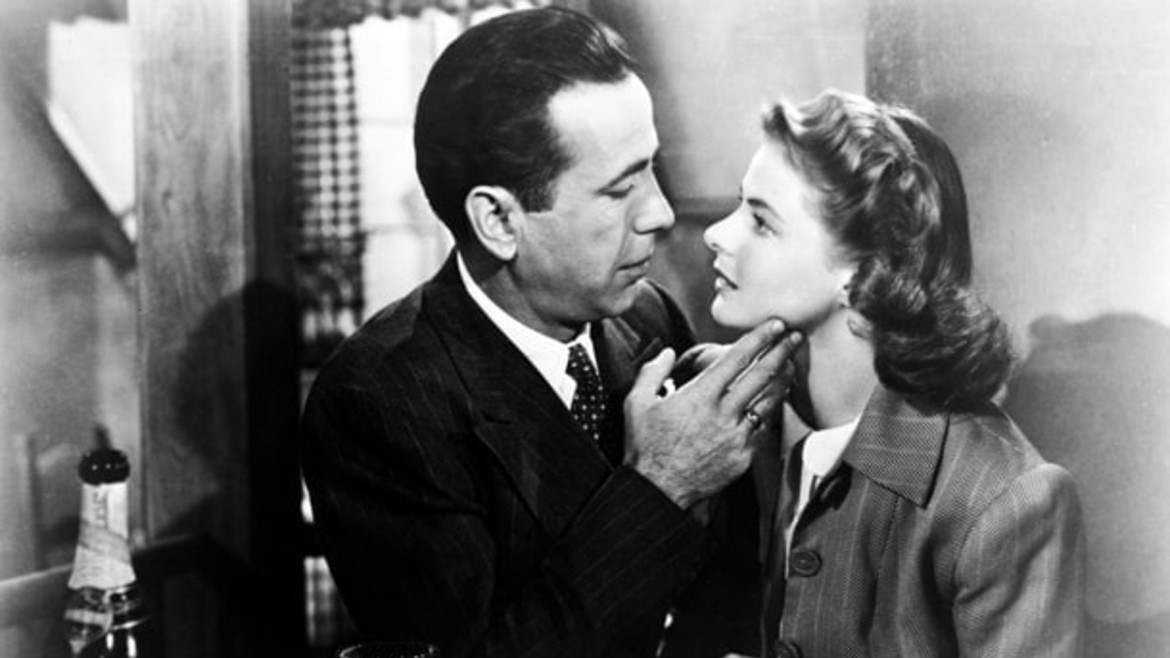Into Film Clubs
Find out everything you need to know about starting an Into Film Club.



Below, we're exploring the era of American film between 1930 and 1960 that the WJEC/Eduqas Film Studies specification identifies as 'Classical Hollywood' (sometimes referred to as ‘Old Hollywood'), before looking at a selection of films on the syllabus and some of the key characteristics that set them apart as Classical Hollywood cinema.
The American film industry is vast in scope but its epicentre lies in Los Angeles, California, specifically an area called Hollywood, where the five major film studios decided to plant their flags in the early twentieth century. For almost its entire history, film has been synonymous with Hollywood and although the landscape of the film industry has changed rapidly over the decades since film became a mainstream artform, Hollywood has remained the leader in budgets, box office and sheer popularity to this day.
There were five major Hollywood studios during the classical era, some of which are still at the top of the pyramid today: Paramount, Warner Brothers, 20th Century Fox, RKO and Metro-Goldwyn-Mayer (MGM). The studios were funded, owned and operated by businessmen and they were all "vertically integrated". "Vertical integration" meant that the studios handled the production (the casting, writing, filming etc), the distribution (marketing, materials) and exhibition (owning the cinemas themselves) of the entire film industry. Stars were the most integral part to a film's success, due to the audience fascination with actors on-screen personas and personal lives the biggest stars of this era largely ensured that films would make a profit at the box office. With production budgets being very tight during the war and post- war period in Hollywood, the total command over every aspect of a films production allowed studios to have an unprecedented level of power over spending that has not been seen since, at least in a business sense.
By highlighting some of the identifying features of Classical Hollywood films that rose from this economic situation, we can learn about how the film industry was operating at the time, how the art form of film was evolving and how societal/cultural notions of the time were shaping, or being shaped by, the films being made. All the films discussed below are available to stream for schools to stream for free* with Into Film+.
The earliest film from this period on the syllabius is Casablanca, produced in 1942, and directed by Michael Curtiz. Casablanca, which tells the story of a mysterious American expatriate who is reacquainted with his former lover in Morocco, performed considerably well, though not spectacularly, at the box office during its initial release yet has since become known as a definitive film of this era. With the war not yet won, Casablanca provided both escapism and patriotic entertainment for audiences but a chief aspect of Casablanca that makes it so instantly recognisable as a Classical Hollywood film is its approach to dialogue and story.
Since the breakthrough of sound technology in film during the late twenties, and its subsequent brisk evolution, Hollywood had been taking full advantage of this new aspect of the medium. By 1942, rapid-fire dialogue and voiceover had become the preferred way to communicate the plot for audiences and filmmakers so its no surprise that Casablanca opens with a voiceover narrating the current global political climate over newsreel footage. In 30 seconds, in sets the scene before we are introduced to the film's characters who are given some of cinema's snappiest dialogue which, to this day, has remained iconic. Humphrey Bogart, whose star persona was built around him being a hard-boiled cynic with a secret heart of gold, casually delivers some of the most quoted lines of the Classical Hollywood period such as "here's looking at you, kid" and the iconic final line of dialogue of the film. With strong thematic beats regarding sacrifice and passion, Casablanca could be seen as the prototypical Classical Hollywood film that has also stood the test of time and continues to make modern audiences swoon.
For a deeper understanding of how Casablanca fits into the Film Studies curriculum, check out our new Film Introductions resource on the film alongside our film guide written for A-Level Film Studies learners.
Sharp-witted, engrossing and populated with memorable, idiosyncratic characters, All About Eve has become a canonical staple of Classical Hollywood cinema - yet could also be identified as one of the more modern films to come out of this era. Told over a number of years and blending fiction with reality, the film focuses on two women - the established theatre actress Margo Channing and the ambitious young ingénue Eve Harrington, whose encounter backstage after one of Margot's performances ignites a black comedy narrative that has inspired countless stories since.
The film, directed by the legendary filmmaker Joseph L. Mankiewicz and winner of 6 Academy Awards, was a trailblazer in many ways. As well as being an early example of a screenplay delving into the myth-making and star-power of Hollywood movie-making, it also highlighted the toxic nature of showbusiness, in particular the way that women are presented and perceived by those in power. Viewing this film through a modern lens, and especially in a classroom environment, can yield stirring conversations about empathy, feminism and the role that media plays in shaping our world and the stories within it.
In the intervening years, a number of Hollywood classics were released throughout the 1940s and 1950s including All About Eve, It's a Wonderful Life and Singin' in the Rain from notable directors such as Joseph L. Mankiewic, Frank Capra and Stanley Donen. By the late 1950s, the Classical Hollywood period was both in full-swing and nearing its end. This late period though, gave us a huge swathe of films that epitomise the style and substance of the era. One of these is Vertigo (1958) which, for many, is in the conversation for the best film of all time. A major reason it is seen as such a landmark moment in cinema, and one of the primary reasons it features is because, as per the WJEC/Eduqas syllabus, it "contains the perfect blend of auteur filmmaking (incorporating Hitchcock's ‘signature' style and themes) and Classical Hollywood style".
In this case, "auteur filmmaking" refers to the theory that a film can be analysed through the lens of its director who is considered the primary author of what we see on screen. Hitchcock's directing style was one of Classical Hollywood's most recognisable throughout his entire filmography: he championed innovative camera techniques and prioritised suspense and imagery above dialogue, yet his films still utilised the star personas of Hollywood's biggest actors, such as James Stewart and Janet Leigh, to both comply to and subvert audience expectations.
Hitchcock and Vertigo helped usher in a new era of Hollywood film being seen as an intellectual pursuit and not solely for the purpose of escapism and entertainment. His films were still gripping and accessible but with an underlying psychological aspect to them too. There is evidence of all of this during one of Vertigo's most famous sequences in which the protagonist, private detective John Ferguson, follows a mysterious woman throughout the city of San Francisco and its naturally beautiful outskirts. The vibrant colour, surreal music and intoxicating camerawork create a very specific, scintillating atmosphere that influenced filmmaking for decades to come, and continues to do so.
The German-born director Douglas Sirk's film Imitation of Life (1959) is a late-period Classical Hollywood film and the last of his Hollywood career. Sirk specialised in melodrama, films typified by heightened theatricality, in both performance and set, and the prioritisation of a highly emotional story over detailed characterisation. These kinds of films were very popular at the box office (Imitation of Life was the 6th highest grossing film of the year) and particularly appealed to female audiences, but came to be known, rather derisorily, by the male-dominated cinema space as "women's pictures". Imitation of Life uses these specific genre-stylings to tell an accessible story regarding social issues such as Black American identity and women's ambitions, following the lives of a white widow who dreams of stardom and the Black single mother who becomes her maid. Visually, the film stands out from other films of the Classical Hollywood era due to its lavish sets and outwardly bright and luxuriant colour palette, often used by Sirk to mirror or embellish the characters' emotional states.
The film is also quite different from the others on the syllabus due to its setting and locations mainly domestic spaces and recognisable, almost mundane, localities. This allowed Sirk to use the characters' environment as a means of expressing their mental states or social status, digging into the deeper themes of the film in ways that dialogue, voiceover or action could not. Imitation of Life also contrasts the aforementioned Classical Hollywood films in terms of performance: the exaggerated approach to acting of Lana Turner (Lora) and Juanita Moore (Annie), due to the film's melodramatic style, is not seen as much in contemporary cinema, giving learners the chance to analyse where else they may see this in the media that they consume today. The climatic final scene between Lora and Sarah Jane, Annie's daughter, is a particularly notable example of this.
The final Classical Hollywood film on the Eduqas/WJEC syllabus that you can find on Into Film+ is the masterful comedy film Some Like It Hot (1959). With its slapstick elements, physical comedy and screwball dialogue, Some Like It Hot has stood the test of time whilst also being described as a "cine-literate" comedy, meaning it contains many allusions and references to other Hollywood genres, films and styles (such as noir, the gangster film and the musical). Following the story of two hapless musicians who decide that dressing up as women is the best way for them to escape the violent gangsters on their trail, the film delves into relationship dynamics and entangled identities, and subverts the traditional gendered roles audiences were used to seeing on-screen during this period. The witty, quickfire dialogue that defined much of the Classical Hollywood era is very much present here and although colour film was being widely used at the time (technicolour famously pops off the screen in the aforementioned Vertigo), Billy Wilder opted to shoot the film in black and white, evoking a previous period of Classical Hollywood film despite the impending culmination of the era.
Billy Wilder, another director now considered an auteur who worked seamlessly within the Classical Hollywood studio setup on films such as Double Indemnity (1944), Sunset Boulevard (1950) and The Apartment (1960), cast Marilyn Monroe in the film, a cultural icon who appears here in arguably her most famous role as the hilariously named Sugar Kane. Sugar Kane's depiction in Some Like It Hot is a major reason why the film appears on the WJEC/Eduqas syllabus. Whilst the film and the characters certainly sexualise Monroe's character at the beginning of the film, from the way the camera highlights her body and overt sexuality through the use of close-ups and mise-en-scène, Wilder makes sure to show the audience that, through their own experience dressed as women, the two male leads come to sympathise with Sugar Kane and begin to question their roles in society as men.
What makes Classical Hollywood such an entertaining and valuable period of film, along with the huge stars, lavish sets and snappy dialogue, are the original and engrossing stories that still resonate with audiences of various age groups to this day. There is much more to explore when it comes to Classic Hollywood film and Into Film will be adding further titles that are on the WJEC/Eduqas, OCR, and MIA syllabi in the future so keep an eye on this page for updates.
To access Into Film+, all you'll need is an Into Film Account - it's completely free*, and only takes a moment to set up. Into Film+ is free to use for all UK state schools that hold a valid Public Video Screening (PVS) Licence from Filmbankmedia.
Filmbankmedia PVS Licences are paid for on behalf of schools by all local authorities in England and by some local authorities in both Wales and Scotland. Into Film NI cover the license cost for some schools in Northern Ireland. For further information on licensing in your locality please see our FAQs.
If you're a state school in England that's funded by the Department for Education, you will automatically have access to Into Film+ Premium, which offers an extended catalogue of 500+ titles. Find out more about Into Film+ Premium in our FAQs.
If you don't have a PVS Licence, or aren't already covered, then a licence can easily be obtained from Filmbankmedia.

Filmbankmedia licenses and distributes film and TV entertainment to many groups and is the licensing authority we work with to ensure schools, libraries and youth groups have the permissions to screen films from our catalogue.
* Screenings for an entertainment or extra-curricular purpose require a PVS (Public Video Screening) Licence from Filmbankmedia. State-funded schools in England are covered by the PVS Licence.
The core Into Film programme is free for UK state schools, colleges and other youth settings, thanks to support from the BFI, awarding National Lottery good cause funding, and through other key funders including Cinema First and Northern Ireland Screen.
Find out all about the Into Film+ streaming platform, and check out the latest films added and available to stream.
View other Articles in this columnViewing 4 of 4 related items.

Get in touch with your article ideas for the News and Views section.